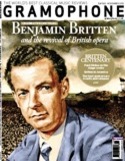Texte paru dans: / Appeared in:
*

GRAMOPHONE (11 /2013)
Pour s'abonner /
Subscription information
Harmonia Mundi
HMC 802156/58

Consultez toutes les évaluations recensées pour ce cd
~~~~ Reach all the evaluations located for this CD
Reviewer: Jonathan
Freeman-Attwood
Jacobs’s
exploration of spatial depth in the Matthew Passion
The appetite for evolving performance practices in Bach’s St Matthew Passion
appears undiminished as we have gradually shifted, over the generations,
from larger to smaller ensembles and also towards a greater dramatic
understanding of the implications of Bach’s ambitious ‘stereophonic’ double
choir and orchestra choreography.
René Jacobs has never been shy of a new hunch and taking it as far as (and sometimes beyond) what is either reasonable or defining. His revision of the idea of how the St Matthew was performed in St Thomas’s, Leipzig, is predicated on the belief that the experience for listeners – before the organ in the Swallow’s Gallery was dismantled in 1740 – was a spatial perspective of depth, not width: in other words that the first ‘choir’ of participants in the large west gallery provided verbatim Gospel action (complete with Evangelist and Christus) while, far down the nave, the second ‘choir’ offered human reaction and reflection. In reality, one imagines that the exact position of the worshipper’s seat may have had something to do with the impact of this ambitious scheme.
Recordings can create ideal dialogues often unrealisable in performance but this isn’t the case here, where the problem is twofold. Building ‘worlds’ – or arias – unto themselves and placing them within the unfolding dramatic summa is the ultimate challenge for any director but inconsistency of singers has historically undermined many a finely gauged performance. As well as this, the spatial agenda appears to accentuate the least convincing vocal contributions.
Jacobs has a magnificent vocal presence of soloists from Choir 1 – led by the polished and increasingly believable Evangelist of Werner Güra (supported by as kaleidoscopic a continuo as has ever been committed to disc) and a Christus in Johannes Weisser who is intensely human, even febrile as he confronts the terrible events one by one. The other basses are generally accomplished although the singer is not listed in ‘Mache dich’ – notable for its panache as well as fussy and misplaced ornaments in the da capo.
How the seasoned Bernarda Fink glows in ‘Buss und Reu’, and what a let-down when, next up, the rather less accomplished Christina Roterberg fails to project ‘Blute nur’ from Choir 2 far down the nave. Likewise, the ruddy ‘Gebt mir’ is barely decipherable in the sonic mist. The accompanying DVD shows a studio circle in which Jacobs turns around to each choir; but technology does the singers few favours in creating the aural equivalent of looking down the wrong end of a telescope.
If this is not always the case, such as in the outpouring of personal loss in the tableaux from ‘O Schmerz’, where distance is eerily telling, the hollow sound is seldom transcended by vocal presence or clear enunciation. The movements in which both choirs transact – none more riveting than the distance between the physical and the metaphysical imagery in ‘So ist mein Jesus nun gefangen’ – are far more effective. The opening chorus, too, is imbued with a luminous foreboding, silvery strings hovering, internal bittersweet shading and rich choral contrasts. The doubling-up the octave of the chorale ‘O Lamm Gottes’ by the organ is a striking addition.
Jacobs’s attention to texture and matters of accentuation is what defines his most compelling short-term characterisation, and the dialogue between Evangelist and Christus carries the Passion story with unfailing colour, vitality and genuine emotional investment. No one can doubt Jacobs’s profound identification with this work but, tantalisingly, the idea and the ideal are too far removed from one another.
This is a Passion performance with admirable scenes, often impressively coherent, but musically the overall effect is surprisingly disjunct. The heavy-going DVD conveys blocks of recording work complete with gesticulations from the least succesful singers, alongside the thoughtful ruminations of Jacobs and Fink. An emblem of the extremes here of the very good and the rather disappointing.
~~~~~~~~~~~~~~~~~~~~~~~~~~~~~~~~~~~~
Lindsay Kemp's session report on René Jacob's
St Matthew Passion in:
gramophone.co.uk./features
Cliquez l'un ou l'autre
bouton pour découvrir bien d'autres critiques de CD
Click either button for many other reviews


